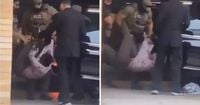In the early morning hours of August 16, 2025, a tense encounter in San Bernardino County, just east of Los Angeles, has thrown a spotlight on the strained relationship between federal immigration authorities and local communities in Southern California. According to the Department of Homeland Security (DHS), what began as a targeted immigration stop swiftly escalated into a dramatic scene involving smashed car windows, a fleeing vehicle, and gunfire—all captured in part on video by the family involved.
It was just before 9 a.m. when federal agents, identified by their marked vests and hats emblazoned with "CBP" for Customs and Border Protection, approached a parked vehicle. Inside were a 43-year-old man from Mexico—who, as reported by the Inland Coalition for Immigrant Justice, has lived in the United States for 23 years without legal status—his 18-year-old son, and his 23-year-old son-in-law, both of whom are U.S. citizens. The officers, their faces masked, asked the driver to roll down his window. The driver refused, and a tense exchange followed, with one of the passengers asking, "What do you want?"
The situation deteriorated rapidly. The agents smashed the windows on both sides of the vehicle, and as the glass shattered, the driver sped off, reportedly striking two federal agents in the process. In response, one agent fired three shots at the fleeing car. The shots missed, and no injuries were reported, but the incident was far from over.
The driver, whose name remains undisclosed, immediately called the San Bernardino Police Department, telling officers that masked men had pulled him over, broken his car window, and fired at him. The police responded to his home, spoke with him, and ultimately left without taking him into custody. As the department explained in a statement, California law prohibits local police from assisting federal officials with immigration enforcement—a policy that has long been a point of contention in the state.
Federal agents later arrived at the man's home, but, lacking a warrant, were denied entry by his family, according to Javier Hernandez, executive director of the Inland Coalition for Immigrant Justice. The standoff quickly drew a crowd outside the residence, prompting San Bernardino police to return—not to make an arrest, but to help with crowd control and ensure the situation didn't spiral further.
The Department of Homeland Security was quick to criticize the local police's decision not to detain the driver. In a sharply worded statement, DHS said, "This reckless decision came despite the subject’s outright refusal to comply and his wounding of two federal officers. It is yet another tragic example of California’s pro-sanctuary policies that shield criminals instead of protecting communities." This sentiment reflects a broader frustration among federal authorities over what they see as obstacles to enforcing immigration law in so-called "sanctuary" jurisdictions—areas where local governments limit cooperation with federal immigration agencies.
There is, in fact, no universal definition of a "sanctuary" jurisdiction, but the term is widely used to describe local and state governments that restrict their involvement in federal immigration enforcement. California, with its diverse and sizable immigrant population, has been at the forefront of this movement, passing laws that prohibit local law enforcement from participating in certain federal immigration activities. These policies have drawn both fierce support and sharp criticism, depending on whom you ask.
On the ground, the impact of these policies is deeply felt. According to the Associated Press, the man and his family declined interview requests, but their experience—partly documented by cellphone video—has become a flashpoint in the ongoing debate over immigration enforcement. The video, shot by the driver's son and son-in-law, shows the officers demanding compliance, the windows being smashed, and the chaos that followed as the car sped away and gunshots rang out. Notably, the footage does not show the agents being struck by the vehicle, a detail that has fueled further questions among community advocates and legal observers.
As the story spread, local community leaders and immigrant rights advocates voiced deep concerns about the implications for trust between law enforcement and immigrant communities. Many worry that such confrontational tactics—especially when they involve force or the threat thereof—only deepen the divide and make it less likely that immigrants will cooperate with police, even in situations unrelated to immigration status. As one advocate put it, "Incidents like this do not just affect one family; they send ripples of fear and mistrust through entire neighborhoods."
The Department of Homeland Security, meanwhile, has launched an internal review to determine whether the agents followed protocol and whether the use of force was justified under the circumstances. According to DHS, the agents were conducting a "targeted enforcement operation," though details about why the man was targeted have not been made public. The agency's investigation will examine the sequence of events that led up to the shooting, the decision to smash the car windows, and the moments when the agent fired his weapon.
For many in Southern California, the incident is a stark reminder of the heightened tensions that have characterized federal immigration enforcement in recent years. Under the Trump administration, a crackdown on illegal immigration led to a surge of raids across the Los Angeles region, sparking protests and even the deployment of the National Guard and Marines in the city for nearly two months. Legal battles over the scope of federal authority continue, with recent court orders placing limits on indiscriminate stops and arrests—restrictions that the federal government has challenged all the way to the Supreme Court.
As the investigation into the San Bernardino incident unfolds, calls for transparency and accountability are growing louder. Advocates are demanding a full accounting of what happened and why, arguing that only by confronting the facts can trust begin to be rebuilt. Local officials, for their part, are urging residents to remain calm and avoid speculation until the inquiry is complete. But with emotions running high and national attention focused on the case, it is clear that the outcome of this investigation will reverberate far beyond the streets of San Bernardino.
In the end, the events of August 16 have become more than just another entry in the long and complicated history of immigration enforcement in California—they have become a catalyst for renewed debate about the balance between public safety, individual rights, and the responsibilities of those tasked with upholding the law.


